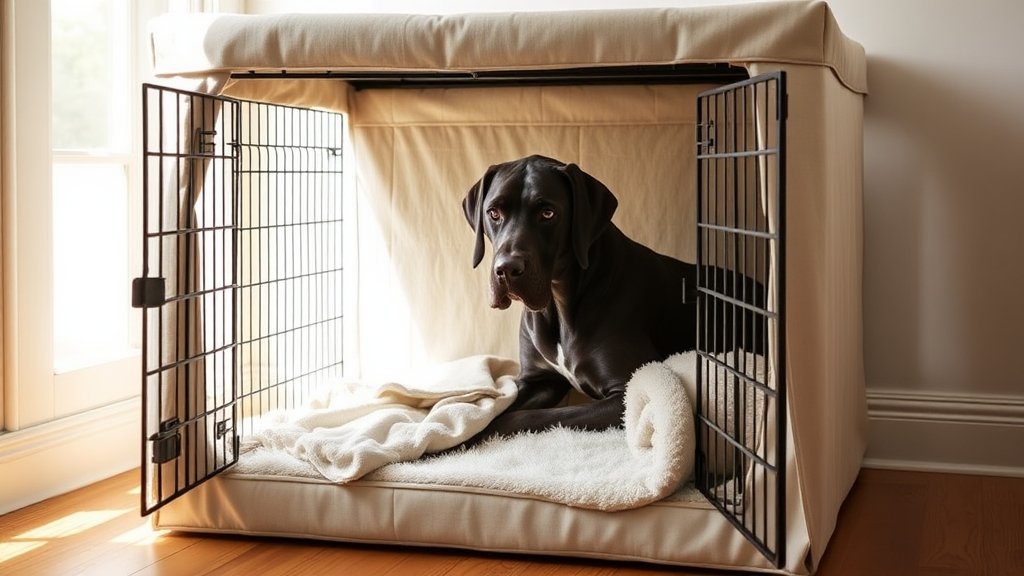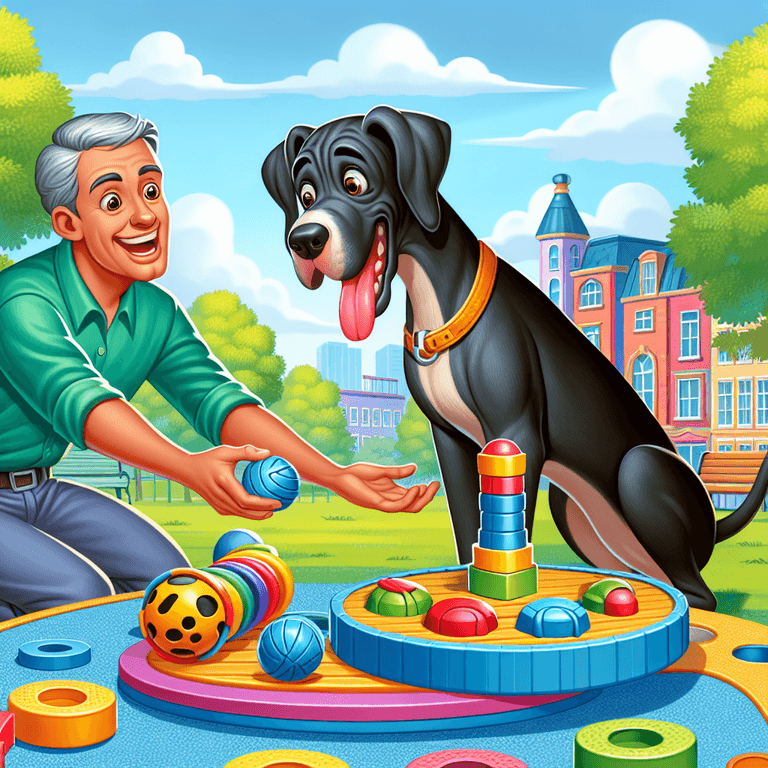Crate Training Great Danes
Great Dane Crate Training
Woof! So you want to get me one of those metal boxes humans call a “crate”? Listen, I’m enormous, so you better make sure it’s super strong and made of steel. Measure how tall I am and how long I am, then add four more inches – trust me, I need my space to stretch these giant paws!
Here’s the secret to making me actually like this crate thing: fill it with all my favorite stuff! Toss in some tasty treats, my comfy blanket that smells like home, and definitely my squeaky toy. Let me sniff around and check it out on my own – no pushing this Great Dane into anything I’m not ready for!
Start small with me, okay? Five minutes feels like forever when you’re learning something new. Then each week, make it a little longer. I’m smart, but I need time to figure things out. Do this every single day at the same time so I know what’s coming.
Oh, and here’s a genius move – feed me my dinner in there! Nothing says “this place is awesome” like my food bowl. Just remember, never put me in there when I’ve been naughty. That’s not cool and will make me hate my new space.
Follow my advice, and soon I’ll be a crate training superstar! Well, a huge superstar who needs an extra-large crate, but you get the idea.
Choosing the Right Crate for Your Great Dane
Hey there, fellow humans! It’s me, your friendly neighborhood Great Dane, Yeti, and I need to talk to you about something super important – my house! Well, what you call a “crate,” but I like to think of it as my personal mansion.
First things first – SIZE MATTERS when you’re as magnificently huge as me! I’m not kidding around here. You wouldn’t want to live in a tiny closet, would you? So, please measure how tall I am and how long I stretch out, then add four inches in each direction.
SIZE MATTERS for Great Danes! Measure your magnificent beast and add four inches each way – no tiny closets for royalty!
Trust me, I need room to stand up without bonking my head (ouch!), turn around without getting dizzy, and stretch out like the majestic beast I am. But don’t go crazy and get me a football stadium either – too much space and I might forget my house training. Nobody wants that mess!
Now let’s talk materials. I’m a furry bulldozer with a tail that could knock over a small child, so those flimsy wire crates? Yeah, those are more like suggestions to me.
Get me the heavy-duty steel stuff! I promise I’m not planning any great escapes, but when I get excited about dinner or the mailman, things can get a little… energetic. Steel crates can handle my enthusiasm without falling apart. Remember, heavy-duty metal crates are ideal due to their superior strength and durability. Crate training also helps in establishing a safe and comfortable space for me.
Make sure my new palace has strong corners and locks that work. I don’t want my house collapsing when I’m trying to take my seventeenth nap of the day!
Building Positive Crate Associations From Day One
My humans are teaching me that my crate is pretty awesome! At first, I thought it was some giant dog house punishment, but boy, was I wrong. They never shove me in there like I’m being sent to my room. Instead, they toss in my favorite treats and let me figure out that good things happen when I walk in by myself.
The best part? They put this super fluffy bed in there that’s almost as comfortable as the couch I’m not supposed to sleep on (but totally do when they’re not looking). Proper crate training is essential for helping me feel secure in my space.
Every time I go in, they act like I just learned how to do brain surgery or something. “Good boy!” they shout, and suddenly, more treats appear like magic.
Now I’m starting to get it – this crate thing isn’t a prison. It’s like my own personal cave where nobody bothers me when I want to nap, which is 18 hours a day.
Plus, when I’m feeling overwhelmed by all the tiny humans visiting our house, I can retreat to my safe space and watch the chaos from a distance.
Sometimes I even go in there just because I want to, and my humans act like I’ve just won the Nobel Prize. Using positive reinforcement helps me feel secure and happy in my crate, making it a place I enjoy.
Humans are weird, but I like the treats, so I’ll play along.
Voluntary Entry Encouragement
Woof! Let me tell you about this peculiar human obsession with trying to put me in a box. They call it “crate training,” but I call it “Operation Make the Giant Dog Fit in a Cave.”
My humans have three big rules they keep mumbling about: be patient (which is hilarious coming from someone who can’t wait two seconds for their coffee), use positive reinforcement (a fancy way of saying “bribe me with snacks”), and be consistent (good luck with that, humans).
So here’s how this game works. My humans started throwing the good stuff – and I mean the REALLY good stuff like that magical freeze-dried liver and cheese – into this big box thing. At first, I was like, “Nice try, humans, but I wasn’t born yesterday.”
But then I smelled that cheese, and suddenly the box didn’t look so scary. Great Danes have a calm nature, allowing them to adapt well to crate training with the right encouragement.
They invented a game called “Find It,” where they hide treats all over the crate. Honestly, it’s like Easter morning every day! I get to use my super-sniffer powers and get rewarded for it.
My humans are finally learning how to play proper games.
The best part? They never slam the door shut like some doggy prison. I can waltz in and out whenever I want, which makes me feel like the boss I obviously am.
Every time I take even one step toward the crate, they act like I just won the Westminster Dog Show. More treats, more praise – these humans are easy to train! Establishing clear communication is essential for good manners, and I think my humans are finally getting the hang of it.
Reward-Based Training Methods
Woof! My Human’s Plan to Make Me Love My Crate
My human thinks they’re so smart with their “four core strategies” to make me love this giant box they call a crate. But honestly? I’m starting to think they might be onto something!
First, they started putting these amazing treats right by the entrance. I’m talking the good stuff—not my regular kibble, but those drool-worthy chicken bits I only get on special occasions. My human calls it “positive reinforcement,” but I call it “finally understanding what motivates a Great Dane!”
The timing thing is pretty important too. When I walk into the crate (and trust me, at my size, it’s more like carefully folding myself in), my human immediately showers me with praise and gives me my favorite squeaky elephant. No waiting around—instant party! Same thing when I’m just chilling inside without whining. Good behavior equals immediate rewards. I can work with that system.
We started with really short visits. Like, just long enough for me to grab the treat and back out. Smart move, human! Now I can stay in there for longer stretches without feeling trapped. Adaptive intelligence is kicking in!
Here’s their master plan broken down:
| What’s Happening | What I Get |
|---|---|
| Just sniffing around the entrance | Those special liver treats |
| Actually going inside | Instant praise plus my elephant toy |
| Staying calm when the door closes | A puzzle toy stuffed with food |
| Hanging out for longer periods | Rotating selection of awesome chews |
| Making it through the whole night | Epic morning celebration |
The puzzle toy trick when they close the door? Genius! Hard to be anxious about being “trapped” when I’m busy figuring out how to get peanut butter out of a Kong. And those rotating chews for longer stays keep things interesting. Yesterday it was a bully stick, today it’s a frozen marrow bone.
But the morning celebration ritual might be my favorite part after I spent the whole night in my crate like a good dog, my human acts like I just won the Westminster Dog Show. Lots of “good boy” in that high-pitched voice, belly rubs, and sometimes even a special breakfast. Being in my crate has become a place of positive reinforcement rather than fear, helping me feel safe and secure.
The whole thing went from “scary box prison” to “my cozy den where good things happen.” Pretty sneaky, humans. Pretty sneaky indeed.
Creating Safe Spaces
My Future Crate: Making It Awesome Before I Even Get There!
Hey there! I’ve heard that my humans are getting ready for my arrival, and they’re setting up something called a “crate” for me. This isn’t some kind of doggy jail – it’s supposed to be MY special hangout spot! Pretty cool, right?
Here’s what my smart humans are doing to make sure I LOVE my new personal cave:
- They’re stuffing it with the softest blankets ever, plus some toys that smell like home. I haven’t even sniffed these things yet, but I’m already excited about having my treasure collection! They’re also considering adding some mental stimulation activities to keep me engaged while I’m in there.
- Get this – they’re planning to serve ALL my meals in there! I don’t know about you, but anywhere food happens is automatically my favorite place. Pure genius if you ask me.
- The best part? They promised never to stick me in there when I’m in trouble. Nobody wants their bedroom to feel like detention.
My humans seem to think this setup will help me become a chill, happy pup who WANTS to hang out in my crate. Plus, they know that early socialization is vital for my development, so creating a positive environment is key.
Honestly, with comfy beds AND food involved, they’re probably right. I might never want to leave!
I can’t wait to try out my new digs. This whole “safe space” thing sounds pretty impressive for a growing Great Dane like me!
Step-by-Step Training Approach and Timeline
Woof! So, my humans think they’re being super smart with their “three-phase training plan” – but honestly, I’ve already figured out that this whole crate thing is pretty awesome!
First up is what they call the “exploration phase,” which means I get to explore my new den and come and go as I please. Easy peasy! I’m like a furry detective checking out every corner and making sure no sneaky cats are hiding in there.
Then comes the part where they want me to hang out there for longer periods. They call it “duration tolerance,” but I call it “nap time with snacks.” The trick is to act like I’m doing them a huge favor by staying put – even though I’m secretly loving every minute of my cozy cave time.
The best part? They think they’re training me, but really, I’m teaching them to give me treats every time I walk near my crate. Works every time!
Plus, now I’ve my own personal space where I can hide my favorite tennis ball and escape from the vacuum cleaner monster.
Trust me, fellow Great Danes – this whole crate routine thing is pretty sweet once you get the hang of it. Just don’t let your humans know you figured it out this fast!
Initial Exploration Phase
My Big Adventure: Getting to Know My New Room
Hey there! It’s me, your friendly neighborhood Great Dane, and I’m here to tell you about this weird box thing my humans brought home. They keep calling it a “crate,” but honestly, it looks like a fancy dog house that forgot to grow up properly.
So here’s the deal – my humans are being super sneaky about this whole thing. One day I woke up from my third nap (don’t judge, I’m growing!), and there it was. Just sitting there in the living room like it belonged there. At first, I thought it might be a really boring piece of furniture, but then I caught a whiff of something amazing.
The Great Treat Mystery
My humans started dropping these incredible treats all around this box thing. Not the regular boring kibble – I’m talking about the good stuff! The treats that make my tail go crazy and my drool turn into a small waterfall. They scattered them near the entrance like they were leaving a trail for some giant, four-legged detective. Guess who that detective turned out to be?
The best part is they left the door wide open, so I could investigate without feeling trapped. Trust me, when you’re as big as a miniature horse like I am, feeling trapped isn’t fun for anyone involved.
Dinner Gets Interesting
Then my humans got really clever. They started moving my food bowl closer and closer to this mysterious box. First, it was just nearby. Then it was practically touching the entrance. Finally, they put it right inside the doorway!
I’ll admit, I was initially suspicious. Was this some trick? But my stomach won the argument with my brain (it usually does), and I discovered that eating dinner near my new box was pretty cozy.
Why This Whole Thing Is Pretty Smart
Looking back, I realize my humans were being really cool about this. They never pushed me or forced me to go inside. They just made it seem like the most interesting place in the house.
And since I’m naturally curious (some might say nosy), I couldn’t help but want to investigate it.
The best part? No stress, no scary moments, just lots of treats and patient humans. Even us gentle giants appreciate when things go slow and steady!
Progressive Duration Building
Hey there, fellow Great Danes! So you’ve gotten pretty good at walking into your crate when the humans bring food and treats, huh? Now comes the part where they want us to stay in there for more than two seconds. I know, I know – humans have some weird ideas sometimes.
Here’s the deal: they’re going to start asking us to hang out in our crates for longer periods. Don’t panic! They start super small – like just 5 minutes. That’s barely enough time to figure out which toy you want to chew on.
Check out their sneaky plan:
| Week | How Long They Want Us In There |
|---|---|
| 1-2 | 5-15 minutes (not too bad) |
| 3-4 | 30-60 minutes (long enough for a decent nap) |
| 5+ | 2+ hours (okay, now we’re talking serious nap time) |
The good news? If you act all stressed out and dramatic, they’ll back off and give you more time at the easier levels. So basically, if week 3 feels too long, give them your best “I’m so sad” face, and they’ll probably let you stick with shorter times.
The humans keep saying stuff about “consistency,” which means they’re going to keep doing this every day, whether we like it or not. But honestly? Once you get used to it, the crate becomes pretty cozy. It’s like having your private bedroom where nobody can steal your favorite tennis ball.
Just remember – no rushing allowed in this game. Even us Great Danes need time to get comfortable with new things, and the smart humans know this.
Establishing Effective Crate Schedules and Routines
My Guide to Crate Schedules (From One Great Dane to Another)
Hey there, fellow gentle giant! Let me tell you something – us Great Danes LOVE knowing what’s coming next. It makes life so much easier when our humans stick to a schedule with our crates. Trust me, I’ve figured this whole thing out!
Here’s what works best for dogs like us:
| Time | What I Do in My Crate |
|---|---|
| Morning (7-8 AM) | Chill out for 30-60 minutes after gobbling breakfast |
| Lunch Time (12-1 PM) | Take a nice nap while the humans are being loud |
| Afternoon (3-4 PM) | Play quietly with my favorite squeaky toy |
| Night Time (9-10 PM) | Get ready for the big sleep in my cozy den |
The best part? Once you get used to this routine, you’ll start looking forward to crate time! I know it sounds crazy, but hear me out. When my human sticks to the same time every day, I know exactly when it’s happening—no surprises, no stress – just me and my comfy space.
Plus, having a schedule means I get consistent meal times, potty breaks, and play sessions. And between you and me, sometimes it’s nice to have a quiet spot away from all the chaos. Even us social butterflies need our alone time!
The secret is making your crate feel like the best spot in the house, not a punishment. Once your humans figure that out, you’ll be golden!
Overcoming Common Challenges and Resistance
The Big Dog’s Guide to Surviving the Crate Game
Okay, fellow Great Danes, let’s talk about this whole crate thing our humans are obsessed with.
Even when they think they’ve got us figured out with their fancy routines, we big dogs have our special ways of making things interesting!
We might be giants, but we’ve mastered the art of keeping our humans on their toes with creative surprises!
Sometimes we get stressed about that metal box they call our “room.”
When we start whining, pawing at the door, or doing our best statue impression at the entrance, it’s usually because that crate feels scary or boring.
And don’t even get me started on all the distractions! When the neighbor’s yappy Chihuahua starts his daily concert or the mailman dares to walk past OUR house, how are we supposed to focus on crate time?
Here’s what works for us, gentle giants:
- Take it slow – Start by hanging out near the open crate, perhaps with a good chew toy. No pressure!
- Treats at the right time – The moment we step inside, we should receive that delicious reward. Timing is everything!
- Make it peaceful – A quiet spot away from all the household chaos helps us relax.
Long-Term Benefits of Successful Crate Training
Why Crate Training is Pawsome: A Great Dane’s Guide to the Good Life
Listen up, fellow four-leggers! As a Great Dane who’s been there and done that, let me tell you why crate training is the best thing since squeaky toys. Sure, us humans have to put in some work at the beginning (okay, fine, A LOT of work), but trust me – it’s totally worth it!
Once you get the hang of loving your crate, amazing things happen. I’m talking about becoming the coolest, calmest dog on the block. Here’s what I’ve learned:
| What Gets Better | How Awesome Life Becomes |
|---|---|
| Dealing with Scary Stuff | No more freaking out when thunder booms or fireworks go BANG! |
| Being a Good Dog | Way less trouble for chewing up Mom’s favorite shoes (oops!) |
| Adventure Time | Ready for road trips and sleepovers without losing my cool |
My crate is like my own personal fortress of awesomeness. When the world gets too crazy or loud, I trot over to my cozy cave and chill out. It’s better than any dog bed because it’s MINE. No little siblings (human or furry) allowed unless I say so!
The best part? Once you master crate life, you become a super confident pup who can handle anything. New house? No problem. Vet visit? Piece of cake. Weird relatives visiting? I got this!
Trust me, future you will thank present you for sticking with crate training. It’s like getting a lifetime membership to the Cool Dogs Club!
Final Thoughts
Hey there, fellow giant pups and their humans! So we’ve covered all the big stuff—finding me a crate and helping me actually like this new cave of mine. We discussed how long this whole process takes (spoiler alert: I’m not the fastest learner, but I’m lovable), daily routines, and those moments when I might throw a dramatic tantrum worthy of an Oscar.
But here’s the excellent part: what happens when I finally get it! When my human sticks with all these clever training tricks, something amazing happens. I don’t just learn to hang out in my crate without whining. I get my very own safe space where I can chill out, my human gets to leave the house without worrying I’ll redecorate with toilet paper, and we both get to relax. Trust me, once I master this crate thing, life gets way better for everyone—especially when I stop trying to be a lap dog on the couch!
References
- https://www.dogster.com/dog-training/how-to-crate-train-a-great-dane
- https://greatdanecare.com/ultimate-guide-crate-training/
- https://www.akc.org/expert-advice/training/how-to-crate-train-your-dog-in-9-easy-steps/
- https://www.akc.org/expert-advice/puppy-information/how-to-train-a-great-dane-puppy/
- https://daynakingreatdanes.com/wp-content/uploads/2022/04/Crates-Article-Revised.pdf







3 Comments